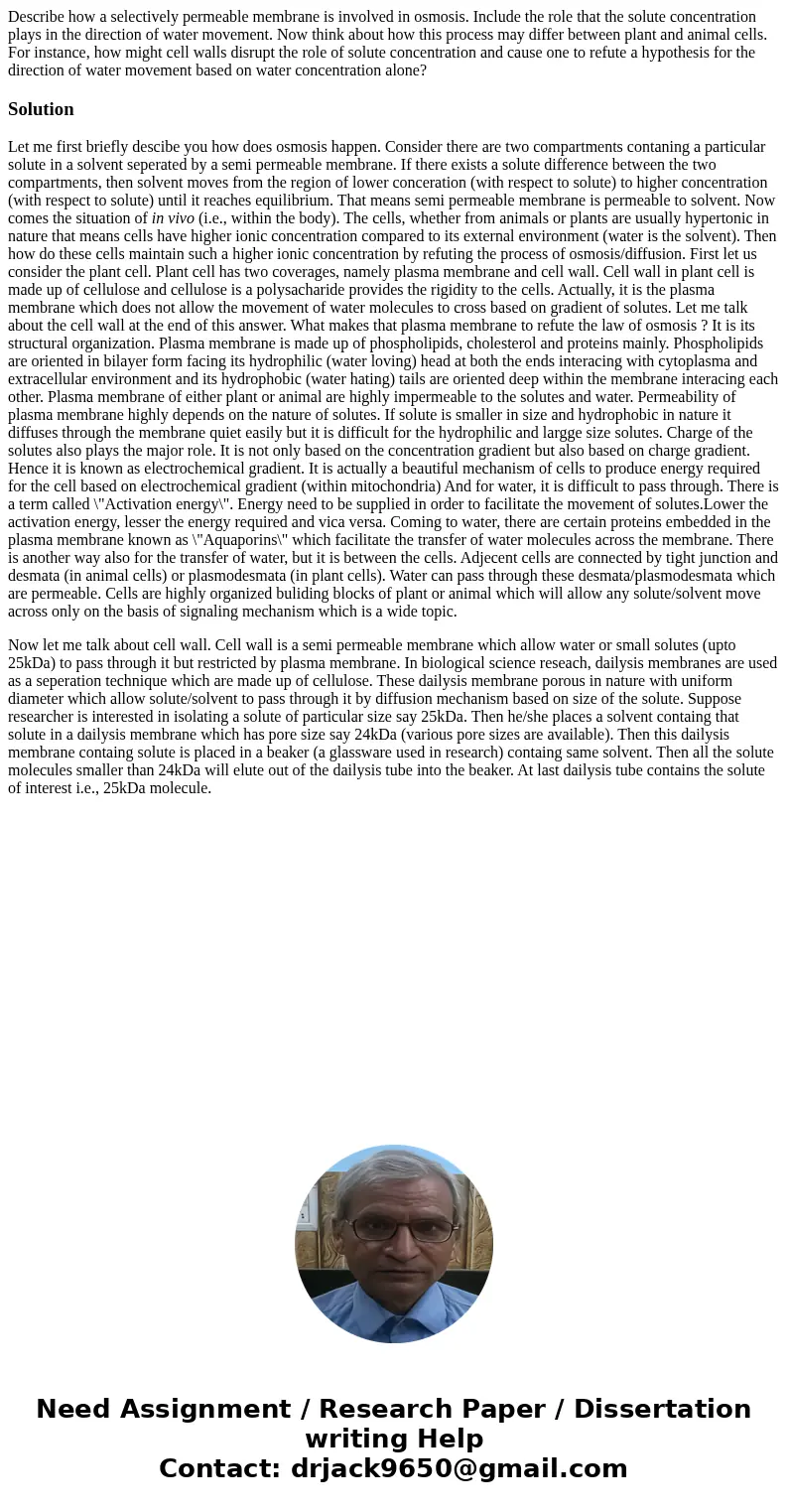Describe how a selectively permeable membrane is involved in
Describe how a selectively permeable membrane is involved in osmosis. Include the role that the solute concentration plays in the direction of water movement. Now think about how this process may differ between plant and animal cells. For instance, how might cell walls disrupt the role of solute concentration and cause one to refute a hypothesis for the direction of water movement based on water concentration alone?
Solution
Let me first briefly descibe you how does osmosis happen. Consider there are two compartments contaning a particular solute in a solvent seperated by a semi permeable membrane. If there exists a solute difference between the two compartments, then solvent moves from the region of lower conceration (with respect to solute) to higher concentration (with respect to solute) until it reaches equilibrium. That means semi permeable membrane is permeable to solvent. Now comes the situation of in vivo (i.e., within the body). The cells, whether from animals or plants are usually hypertonic in nature that means cells have higher ionic concentration compared to its external environment (water is the solvent). Then how do these cells maintain such a higher ionic concentration by refuting the process of osmosis/diffusion. First let us consider the plant cell. Plant cell has two coverages, namely plasma membrane and cell wall. Cell wall in plant cell is made up of cellulose and cellulose is a polysacharide provides the rigidity to the cells. Actually, it is the plasma membrane which does not allow the movement of water molecules to cross based on gradient of solutes. Let me talk about the cell wall at the end of this answer. What makes that plasma membrane to refute the law of osmosis ? It is its structural organization. Plasma membrane is made up of phospholipids, cholesterol and proteins mainly. Phospholipids are oriented in bilayer form facing its hydrophilic (water loving) head at both the ends interacing with cytoplasma and extracellular environment and its hydrophobic (water hating) tails are oriented deep within the membrane interacing each other. Plasma membrane of either plant or animal are highly impermeable to the solutes and water. Permeability of plasma membrane highly depends on the nature of solutes. If solute is smaller in size and hydrophobic in nature it diffuses through the membrane quiet easily but it is difficult for the hydrophilic and largge size solutes. Charge of the solutes also plays the major role. It is not only based on the concentration gradient but also based on charge gradient. Hence it is known as electrochemical gradient. It is actually a beautiful mechanism of cells to produce energy required for the cell based on electrochemical gradient (within mitochondria) And for water, it is difficult to pass through. There is a term called \"Activation energy\". Energy need to be supplied in order to facilitate the movement of solutes.Lower the activation energy, lesser the energy required and vica versa. Coming to water, there are certain proteins embedded in the plasma membrane known as \"Aquaporins\" which facilitate the transfer of water molecules across the membrane. There is another way also for the transfer of water, but it is between the cells. Adjecent cells are connected by tight junction and desmata (in animal cells) or plasmodesmata (in plant cells). Water can pass through these desmata/plasmodesmata which are permeable. Cells are highly organized buliding blocks of plant or animal which will allow any solute/solvent move across only on the basis of signaling mechanism which is a wide topic.
Now let me talk about cell wall. Cell wall is a semi permeable membrane which allow water or small solutes (upto 25kDa) to pass through it but restricted by plasma membrane. In biological science reseach, dailysis membranes are used as a seperation technique which are made up of cellulose. These dailysis membrane porous in nature with uniform diameter which allow solute/solvent to pass through it by diffusion mechanism based on size of the solute. Suppose researcher is interested in isolating a solute of particular size say 25kDa. Then he/she places a solvent containg that solute in a dailysis membrane which has pore size say 24kDa (various pore sizes are available). Then this dailysis membrane containg solute is placed in a beaker (a glassware used in research) containg same solvent. Then all the solute molecules smaller than 24kDa will elute out of the dailysis tube into the beaker. At last dailysis tube contains the solute of interest i.e., 25kDa molecule.

 Homework Sourse
Homework Sourse